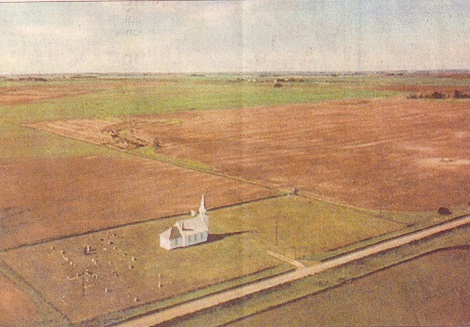

Our
Savior's Scandanavian Lutheran Church in Rural Ward
County,
as seen in this aerial view, has been recently listed in the
National Register of Historic Places
By Mike Manston
Our Savior's Scandanavian Lutheran Church in rural Ward County has been added to the list of the National Register of Historic Places, a division of the National Parks Service.
The church, which is located in Coulee in Northern Ward County, sits on a one-acre plot and was decommissioned as a church in 1963, according to Sandy Burke of Bainbridge Island, Wash. Burke is the person who nominated the structure for the NRHP.
Burke, an architect in the Bainbridge Island area, is the granddaughter of the church's builder, Harold Grenvik. Grenvik and some of his family are buried at the site and the land is minimally maintained by the church's cemetery association.
Burk said that she has submitted applications
for other buildings to be recognized by the NRHP, including a building in
Virginia, and wanted to do something to honor her grandfather and recognize his
work.
Grenvik, a master builder and fine cabinetmaker, also built other
churches and was responsible for other construction in the area, according to
Burke.
Perhaps one of the most interesting features of the church is what is called the Grenvik Steeple-obviously named after its builder. The steeple, which contains a bell (still in working order) is an eight-sided structure that is a combination of intricate Gothic and Romanesque characteristics.
According to Burke, the altar furnishings from the church were also built by Grenvik and are on display at the historical museum in Williston.
"I wanted to do something to celebrate and honor the work of my grandfather, but I also believe that the church played a very significant role in the culture of the immigrants who settled in that area." Burke said. "While I was doing research for the application, I did a lot of interviews and found out a lot of interesting things about the church."
Burke said that the application process was very time-consuming and required extensive documentation. She conducted interviews of people from the area who had things to contribute about the church and made the application about three years ago.
"It went through Washington (D.C.) pretty quickly, but it took about three years to make it through Bismarck," Burke said. "I think my application was the only one to get reviewed by Bismarck this year. I got the application sent back a few times and I had the chance to make a couple additions before it was finally approved by the North Dakota department."
Now that the church has been added to the NRHP, Burke said that she will move forward with the next step of the project, which is to get some sort of recognition plaque erected at the site. She said that although she doesn't make it back to North Dakota very often, she would definitely be willing to come back this summer possibly for a picnic or other type of celebration to get the project completed.
Ward County NDGenWeb Copyright
Design by
Templates in Time
This page was last updated
01/22/2022